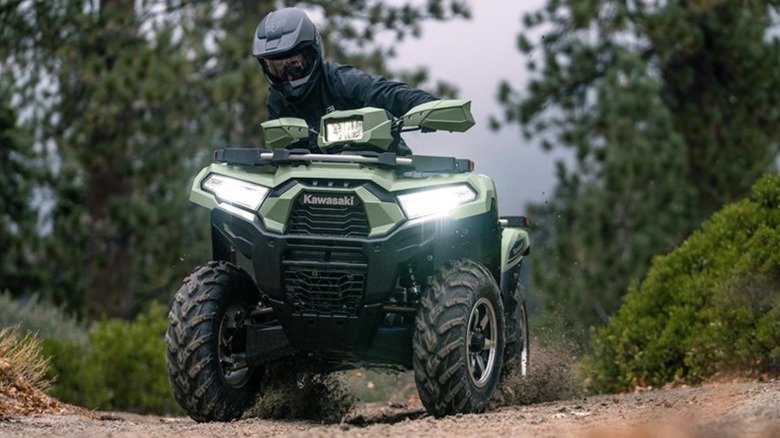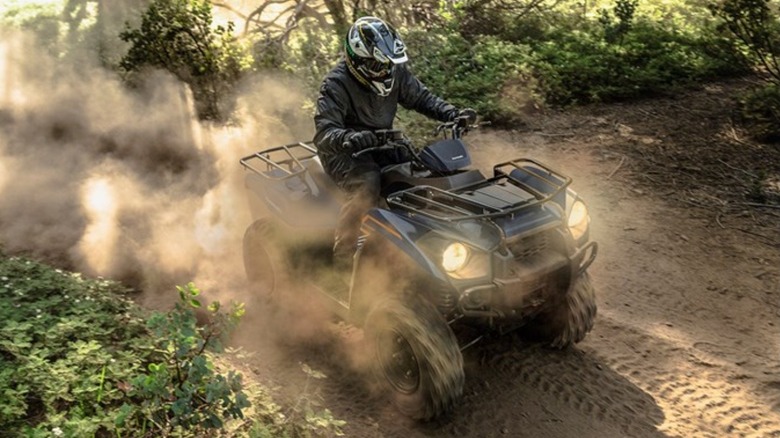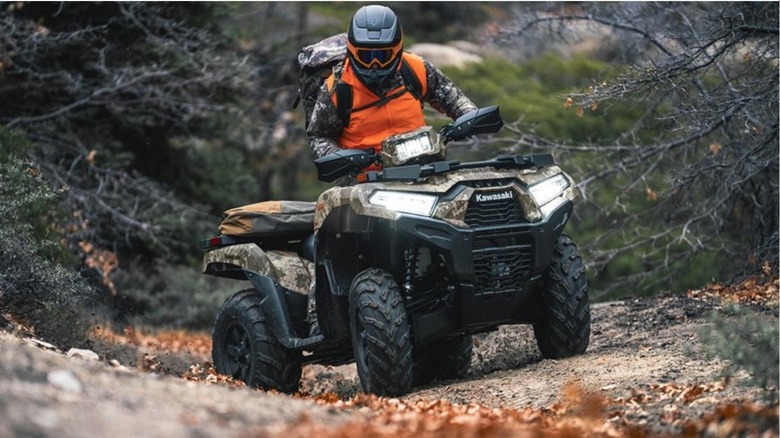Kawasaki Brute Force 300 Vs. 750: What's The Difference Between These ATV Models?
Kawasaki is a brand arguably best known for manufacturing many of the rugged dirt bikes and high-octane motorcycles seen burning up tracks on the motocross and MotoGP circuits year in and year out. But the renowned motorcycle manufacturer has also developed a full line of utility and recreational vehicles, including personal water crafts and, of course, all-terrain vehicles.
Apart from a small line of youth-oriented four-wheeled vehicles, if you're shopping the Kawasaki brand for a big boy or big girl ATV these days, it's pretty much Brute Force or bust. Team Green debuted the Brute Force line in 2005, with the 750 V-Twin powered build and its massive displacement reportedly earning the title of "King of All ATVs." In the almost two decades since, Kawasaki's design team has further built out its line of Brute Force ATVs, which now includes the relatively affordable 300 model.
On the surface level, the two Brute Force builds would seem to share many of the same attributes. But once you do a little digging into the make of each, you'll soon see why the ATVs bear such differing numerical designations, as the differences are stark, to say the least. Here's what sets the Kawasaki Brute Force 300 apart from its 750 counterpart.
The Brute Force 300 is a powerful entry-level ATV
As you might expect given said designation, the Brute Force 300 is indeed Kawasaki's entry-level offering to the line, with a base model coming with a price tag of $5,100. What you get for that entry-level pricing is pretty impressive, however, with the Brute Force 300 boasting a mid-size 271cc 4-stroke, single-cylinder engine capable of pulling a payload up to 500 pounds. Coupled with dual loading racks located at the front and back of the ATV that can support an additional 110 lbs combined (44 lbs and 66 lbs respectively), that makes the lively Brute Force 300 ideal for hauling smaller loads around whatever farm, worksite, or campsite you're navigating.
While that kind of power isn't likely to leave the 300 winning many races, it's enough to ensure you can also just have a good time traversing all the dusty trails and light mountain passes you can find as well. Convenience-enhancing features like the 300's automatic Continuously Variable Transmission (CVT), handlebar brakes, and easy-to-read multi-function display serve to make the ride as easy on you as possible. Meanwhile, independent double wishbone front suspension and swingarm single shock rear suspension ensure your ride will be as smooth as it can be, with 35W headlights making it easy to navigate the wilds as your long day of working or trailing turns into a fun evening ride.
The 750 takes Brute Force to the next level
As for Kawasaki's Brute Force 750, it may still be the "King of All ATVs," with the 2024 models proving the very definition of "luxury all-terrain vehicle." Luxury, of course, isn't the goal of most ATVs, but the 750 seeks to offer comfort, and at a base price of $9,999, Kawasaki appears to have crafted a vehicle that delivers.
Yes, the 750 offers upgrades over the 300 at virtually every turn. That begins with the build, as the 750's double-cradle, high-tensile tubular steel frame is wider, longer, and taller than the 300. Likewise, its front and rear double wishbone, adjustable spring preload suspension, and rack-and-pinion steering ensure a smooth, maneuverable ride, while the 749cc liquid-cooled 4-stroke V-twin ensures you've got enough power and torque to charge through even the muddiest of terrain with relative ease.
The upgraded engine offers significantly increased towing capacity, too, with the 750 capable of pulling 1250 pounds in addition to the combined 264 supported by the front and rear racks. The selectable 2WD and 4WD functionality also makes it easy to navigate whatever obstacles lay on the road ahead, while its LED lights are an upgrade to the 35W headlights on the 300. Also, unlike the 300, the 750 also comes with a 4.3-inch display screen, which means you can effortlessly see how fast you're traveling as well as how far.


